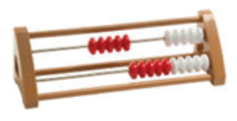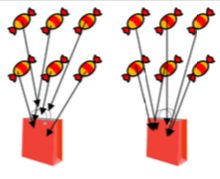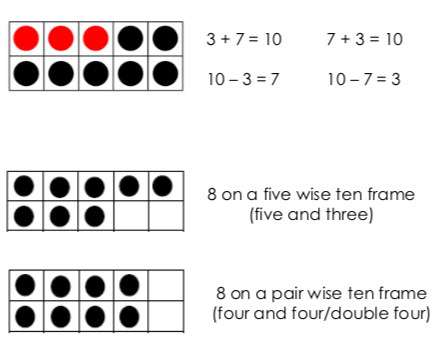| Term |
Description |
Example |
| Array |
A pattern of dots arranged in columns and rows that help us think about multiplication and division. For example,
2 rows of 4 = two fours = 4 + 4 = 4 x 2 = 8
4 rows of 2 = four twos =
2 + 2 + 2 + 2 = 2 x 4 = 8
8 spots shared equally between 2 rows gives 4 in each row: 8 ÷ 2 = 4
8 spots grouped in twos makes 4 groups:
8 ÷ 4 = 2 |
 |
| Bead String |
A string of ten beads grouped in fives which helps young children ‘see’ number facts to ten. For example,
10 is one less than 9 10 – 1 = 9
7 is two more than 5 7 = 5 + 2 |
 |
| Double |
To double a number means to add two numbers that are the same together. For example, 1 + 1, 2 + 2, 3 + 3, 4 + 4….
Young children learn the doubles facts quite quickly by ‘seeing’ them on a *pair-wise ten frame or other classroom materials.
Later, children use these facts to make new facts. For example, 2 + 2 = 4 so 20 + 20 = 40 and 200 + 200 = 40 |
 Double 3 is 6 4 is double 2 Double 3 is 6 4 is double 2
(See also ‘near doubles’ below)
|
| Even number |
An even number is a number that can be divided exactly by two. At first, children will learn that even numbers are numbers that have a ‘partner’.
There are 8 counters. Every counter has a partner so 8 is an even number. |
 |
| Five Frame |
A frame made up of five boxes with a dot in one, some or all of the boxes. A five frame helps young children ‘see’ number facts to five. For example, 3 boxes have dots in them and 2 boxes do not:
3 + 2 = 5 2 + 3 = 5
5 – 2 = 3 5 – 3 = 2 |
 |
| Group |
When we group objects we put them together. Being able to make equal groups is important for understanding of multiplication and division. For example,
How many equal groups of four can you make with twelve pencils?
 3 groups of 4 3 groups of 4
|
2 groups of 3
6 suns grouped in 3s makes 2 equal groups

|
| Near Doubles |
These facts are learned once ‘double facts’ are learned. For example,
15 is a near double. It is double 7 (14) plus 1. It is also double 8 (16) minus 1.
It is double 7 (14) plus 1. It is also double 8 (16) minus 1.
|

9 is a near double – it is double 4 (8) plus 1. |
| Number sentence |
A number sentence is a statement made up of numbers and mathematical symbols.
Teacher may check children’s understanding of word problems by asking them to write a number sentence that matches how they thought about it. For example:
There are 26 girls in P3 and 34 boys. How many P3 pupils are there? |
This number sentence matches the problem on the left
26 + 34 = 60
Discuss with your child:
Is there another number sentence that matches this problem? Does it matter if we start with the number of girls or the number of boys? Why? |
| Odd number |
A number which cannot be divided equally.
At first, children will learn that even numbers are numbers that have do not have a ‘partner’.
There are 9 counters. One counter does not have a partner so 9 is an odd number. |
 |
| Rekenrek |
Sometimes called an ‘arithmetic rack’.
A Rekenrek is a frame with twenty beads grouped in fives (two rows of ten) which helps children ‘see’ number facts to twenty. For example,
17 = 10 + 7
17 = 15 + 2
17 = 5 + 5 + 5 + 2 |
 |
| Repeated Addition |
Adding the same number over and over again to find the answer to a multiplication problem.
Later, children learn that the multiplication symbol (x) can be used as a ‘shortcut’ to repeated addition. For example,
4 + 4 + 4 = 3 x 4 |
3 groups of 4 = 4 + 4 + 4 = 12
 |
| Repeated Subtraction |
Subtracting the same number over and over again to find the answer to a division problem. For example,
4 can be subtracted from 20 three times so
12 ÷ 4 = 3 |
12 – 4 – 4 – 4 = 0 |
| Share equally |
At first, children learn about ‘fair shares’. For example, there are 12 sweets. How can we share them fairly between two party bags? To be fair there needs to be the same number of sweets in each bag.
Equal sharing is an important idea when working with fractions. |
12 sweets shared equally Between 2 party bags will give 6 sweets to each bag.
|
| Skip Count |
Counting in numbers other than one. For example, counting in twos.
We can skip count forwards: 0, 2, 4, 6, 8, 10, 12, 14
We can skip count backwards: 14, 12, 10, 8, 6, 4, 2, 0
Skip counting is useful for counting larger numbers of objects |
Skip count to find how many counters there are:
 Child counts “2… 4… 6.. and one more Child counts “2… 4… 6.. and one more
makes 7”.
|
| Subitise |
Seeing at a glance how many there are, without counting |

I know there are 4 dots. I did not need to count 1, 2, 3, 4. |
| Tally marks |
Tally marks are usually grouped in fives. They can be easily be skip counted to find a total. |

|
| Ten Frame |
A frame made up of ten boxes (2 rows of 5) with a dot in one, some or all of the boxes. A ten frame helps young children ‘see’ number facts to ten. Seeing the ten frame in their mind’s eye helps the child to remember the facts.
Ten frames can be ‘five wise’ or ‘pair wise’.
On a five wise ten frame the numbers 1, 2, 3, 4 and 5 are made on the top row. The numbers 6, 7, 8, 9 and 10 are made as five and some more.
On a pair wise ten frame, the numbers are shown as doubles and near doubles. |
 |
